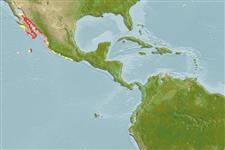>
Blenniiformes (Blennies) >
Chaenopsidae (Pike-, tube- and flagblennies)
Etymology: Acanthemblemaria: Greek, akantha = thorn + Greek, emblema, -atos, anything that is nailed, knocked in; also anything with bass or high relief (Ref. 45335).
Eponymy: Charles Templeton Crocker (1885–1948) was a member of a California family that made its money from railways, having invested in the first transcontinental American railroad. [...] (Ref. 128868), visit book page.
More on authors: Beebe & Tee-Van.
Environment: milieu / climate zone / depth range / distribution range
ນິເວດວິທະຍາ
ສັດທະເລ ກ່ຽວກັນຫີນ; ລະດັບຄວາມເລິກ 1 - 60 m (Ref. 11482). Tropical; 30°N - 14°N, 115°W - 98°W (Ref. 56266)
Eastern Central Pacific: Gulf of California.
ຂະໜາດ / ນ້ຳໜັກ / Age
Maturity: Lm ? range ? - ? cm
Max length : 6.0 cm TL ຕົວຜູ້/ບໍ່ມີເພດ; (Ref. 11482)
Usually found in shallow, rocky areas (Ref. 37955). Inhabits empty worm and mollusk tubes on rocky reefs (Ref. 11482). Feeds on zooplankton (Ref. 11482), benthic invertebrates and small fishes (Ref. 37955). Spawns in the spring (Ref. 37955).
Life cycle and mating behavior
ການຈະເລີນເຕັມໄວ | ການສືບພັນ | ການວາງໄຂ່ | ໄຂ່ | ຄວາມດົກຂອງໄຂ່ປາ | ຕົວອ່ອນ
Allen, G.R. and D.R. Robertson, 1994. Fishes of the tropical eastern Pacific. University of Hawaii Press, Honolulu. 332 p. (Ref. 11482)
IUCN Red List Status (Ref. 130435: Version 2024-1)
Threat to humans
Harmless
Human uses
ເຄື່ອງມື
Special reports
Download XML
ແຫຼ່ງອີນເຕີເນັດ
Estimates based on models
Preferred temperature (Ref.
123201): 20.9 - 27.7, mean 25.2 °C (based on 22 cells).
Phylogenetic diversity index (Ref.
82804): PD
50 = 0.5000 [Uniqueness, from 0.5 = low to 2.0 = high].
Bayesian length-weight: a=0.00537 (0.00278 - 0.01038), b=2.95 (2.78 - 3.12), in cm total length, based on LWR estimates for this species & (Sub)family-body (Ref.
93245).
ຊັ້ນເຂດຮ້ອນ (Ref.
69278): 3.4 ±0.45 se; based on food items.
Fishing Vulnerability (Ref.
59153): Low vulnerability (10 of 100).
Nutrients (Ref.
124155): Calcium = 162 [78, 300] mg/100g; Iron = 0.889 [0.512, 1.566] mg/100g; Protein = 17.9 [16.7, 19.0] %; Omega3 = 0.116 [0.060, 0.218] g/100g; Selenium = 24.2 [10.5, 54.4] μg/100g; VitaminA = 330 [106, 1,083] μg/100g; Zinc = 2.1 [1.3, 3.1] mg/100g (wet weight);
